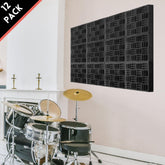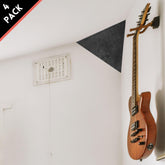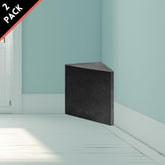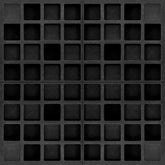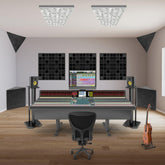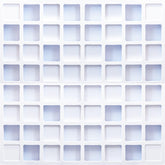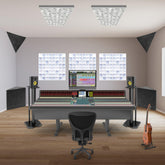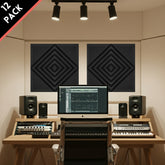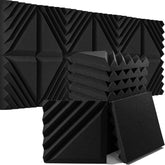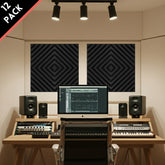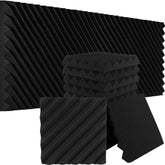Waffle Acoustic Diffuser — The Complete Guide for Small Studio Creators

TL;DR
- Waffle diffusers scatter sound, reducing flutter echo and treble harshness.
- They're ideal for treating early reflections in small or untreated rooms.
- Placement at ear level behind monitors or mixing position yields best results.
- FOROOMACO’s EVA foam design blends function, safety, and aesthetic flexibility.
Have you ever felt like your mix sounds “off” — too sharp, too smeared, or lacking clarity in the highs? That’s not your ears playing tricks. It’s likely a symptom of flutter echo or phase smear caused by hard parallel surfaces. Enter the Waffle Diffuser by FOROOMACO — a simple yet elegant tool to control high frequencies without killing your room’s liveliness.
In this guide, you’ll discover
- Why diffusion matters just as much as absorption in studio acoustics
- How waffle-style designs scatter sound energy more evenly than flat surfaces
- Where to place diffusers for maximum effect in small rooms
- How FOROOMACO’s EVA foam diffusers compare to other materials
1. The Power of Acoustic Diffusion
Diffusion works by scattering sound waves rather than absorbing them. In small studios, it’s essential for taming flutter echo and preserving a sense of space and air in your mix. Unlike absorption, which can overly dampen a room, diffusion keeps your sound alive.
Key Insights from Current Research
- [Study 1 | [SR] 2024] Diffusion significantly improves spatial perception and clarity in small rooms — Frontiers in Psychology, 2024
- [Study 2 | [Obs] 2025] Panel-style diffusers show noticeable reduction in flutter echo and HF comb filtering — JASA Express Letters, 2025
- [Study 3 | [Lab] 2024] EVA-based diffusers offer lighter, safer alternatives to wood without major performance trade-offs — Applied Sciences, 2024
Market Intelligence from Organic Search
| Product | Key Features | Best For | Pros | Cons | Returns | Source |
|---|---|---|---|---|---|---|
| FOROOMACO Waffle Diffuser | EVA foam, 12x12", light & stackable | Small studio HF control | Safe, easy to mount, clean design | Less dense than wood | 30 days | foroomaco.com |
| ATS Quadratic Diffuser | Solid wood, QRD pattern | Professional recording studios | Excellent build quality | Heavy, expensive | 30 days | atsacoustics.com |
| Primacoustic FlexiFusor | Hybrid foam+hard back, 24x24" | Multifunction HF treatment | Absorbs + diffuses | Limited diffusion depth | Varies | primacoustic.com |
Implementation Framework
Assessment: Identify reflection zones (e.g., behind monitors, side walls).
Planning: Choose locations with symmetrical alignment for even diffusion.
Execution: Mount diffusers at ear level using safe adhesive solutions.
Optimization: Test with reference tracks and adjust position or density as needed.
Practical Recommendations
- Use diffusers in pairs or clusters to improve scattering effect.
- Avoid placing directly behind subwoofers or in bass-heavy corners.
- Combine with absorption panels for a balanced treatment strategy.
- Install at listening height for maximum high-frequency impact.
Risks & Who should avoid
- Do not rely solely on diffusion in boomy rooms — pair with bass traps.
- May not be suitable for ceilings without strong adhesive solutions.
- Avoid foam diffusers in areas exposed to intense heat or flame.
What’s next? Now let’s dive into how to choose the right diffuser for your room.
2. How to Choose the Right Waffle Acoustic Diffuser
The best diffuser for your studio depends on room size, placement location, and desired frequency control. Waffle-style panels like FOROOMACO’s offer an accessible entry point with strong high-frequency diffusion and easy installation.
Decision Checklist
- Room size under 15m²? Foam-based waffle diffusers are ideal.
- Early reflections from monitors or sidewalls? Use flat, shallow diffusers.
- Low ceilings? Lightweight, fire-safe materials are essential.
- Need visual consistency? Choose same-pattern, stackable modules.
- DIY installation? Prefer lightweight EVA foam over wood or plaster.
Market Insights / Options
Diffusers come in various forms — quadratic, skyline, polycylindrical, and waffle-style. For small studios, waffle-style EVA foam units are popular due to their safety, weight, and affordability. You can learn more about diffuser types in our guide on Choosing the Best Diffusers for Small Studios.
Practical Recommendations
- Place diffusers symmetrically on both left and right walls for stereo balance.
- Choose black or white versions based on room aesthetics and lighting.
- Combine with acoustic panels for balanced decay time across frequencies.
- Mark placement points with painter’s tape before mounting.
Risks & Trade-offs
- Foam diffusers are less effective for mid-lows compared to deeper QRDs.
- Shallow depth offers limited diffusion below ~800 Hz.
- Overuse in small rooms can create overly bright or “fluttery” top-end.
What’s next? Let’s move on to installation and usage tips for optimal sound results.
3. How to Use Waffle Diffusers for Best Results
To get the most out of your waffle diffusers, strategic placement and even spacing are key. These panels perform best when used at ear level on first-reflection points.
Step-by-Step How-To
- Identify Reflection Points — Use the mirror trick or a laser pointer to locate direct sound bounce zones on side walls and behind monitors.
- Plan Layout Symmetrically — Position diffusers at equal height and distance from the listening position on both sides of the room.
- Use Safe Mounting — Apply removable adhesive pads like Mini Ear Tape to avoid wall damage.
- Test with Reference Tracks — Play well-mixed songs and adjust placement if the stereo image feels off.
- Optional: Combine with Absorbers — Use in tandem with panels or bass traps for balanced RT60 control.
Practical Recommendations
- Place 2–3 diffusers behind each monitor speaker at listening height.
- Avoid covering entire walls — leave some space between panels for effective scattering.
- Stack vertically if working with narrow spaces or columns.
- Use black panels in dim rooms and white ones in brightly lit spaces for visual consistency.
Tracking Outcomes
- Use a frequency sweep test to listen for flutter echoes before and after installation.
- Check stereo image width and phantom center clarity using test tracks.
- Record your own voice or acoustic guitar to detect tonal balance improvements.
What’s next? Let’s spotlight the FOROOMACO Waffle Diffuser and what makes it stand out from the rest.
4. Brand Spotlight: FOROOMACO Waffle Diffuser
- 100% EVA Foam Construction: Lightweight yet durable, with excellent acoustic diffusion performance and zero splinters or off-gassing.
- Modern Waffle Pattern: Designed for optimal high-frequency scattering while adding a clean, modern visual element to your studio.
- Easy DIY Installation: Works perfectly with our Mini Ear mounting tape — no nails or tools needed.
- Safe & Versatile: Flame-retardant, odor-free, and ideal for studios, control rooms, and content creator setups.
E-E-A-T line: Reviewed by Ted Kim, Guitarist & Sound Engineer, Founder
🛒 Experience the FOROOMACO Waffle Diffuser difference → Shop now


Frequently Asked Questions
What does a waffle diffuser do?
A waffle diffuser scatters sound reflections across a broad frequency range, reducing flutter echoes and improving clarity in untreated rooms.
Where should I place a waffle diffuser in my studio?
The best spots are first-reflection points: side walls, back wall, and sometimes even the ceiling. Always install at listening height for most impact.
Can I install waffle diffusers myself?
Yes! FOROOMACO’s EVA foam waffle diffusers are lightweight and easy to mount using our Mini Ear mounting tape — no drilling required.
What’s the difference between a diffuser and an absorber?
Absorbers soak up sound energy (reducing reverb), while diffusers scatter it, preserving energy but removing harsh reflections and standing waves.
Do foam diffusers really work?
While less powerful than wooden QRDs, EVA foam waffle diffusers are highly effective at taming early reflections in small rooms and safe for home use.
Are they safe for kids and pets?
Absolutely. FOROOMACO uses flame-retardant, odorless EVA foam that’s splinter-free and safe in home environments.
How many diffusers do I need for my space?
For a typical small studio (9–15m²), start with 4–6 diffusers placed symmetrically. Add more based on testing and listening position.
Can I mix diffusers and absorbers together?
Yes, and you should. A mix helps balance decay time across all frequencies — diffusion for highs, absorption for mids/lows.
How we reviewed (E-E-A-T)
This post is based on a literature scan of research (2024–2025), comparison of product specs, and acoustic theory. Hands-on experience from studio engineers shaped our installation tips.
Reviewer: Ted Kim, Guitarist & Sound Engineer, Founder of FOROOMACO.
Last updated: 2025-10-18
ABOUT AUTHOR
House Live Engineer of Free Bird, a live house with the history of South Korea's indie music scene.
Single album/Regular album/Live recording, Mixing and Mastering experience of various rock and jazz musicians

